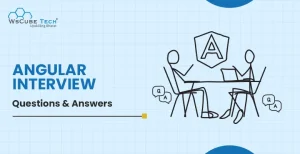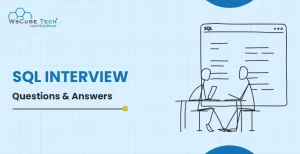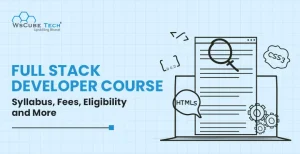The web is a dynamic landscape, constantly evolving with new technologies and captivating user experiences. It is a living, breathing entity, continually pushing the boundaries of what's possible. Front-end development, the art of crafting the user experience (UX) we see and interact with, sits at the forefront of this evolution. As a front-end developer, staying relevant requires a dynamic skill set that adapts to new front end web development technologies and frameworks.
Staying infront of the curve is crucial to thriving in this exciting field. But where do you even begin? Fear not, aspiring developer! This comprehensive guide is your trusted blueprint for a successful career in front end development for 2025. This front end web development roadmap is your compass, guiding you toward a fulfilling career in front end development. So, buckle up and get ready to embark on an exhilarating adventure!
What is Frontend Development?
Frontend or client-side development is building a website or online application's User Interface (UI). It is called client-side because everything in a web application occurs on the end-user device. It determines how each website element will appear and work, which is crucial in shaping the user experience.
Everything you see when you visit a website, such as the buttons and UI components, media, messages, forms, and animations, is produced under the front end.

Who is a Front-end Developer?
A frontend developer, a key player in the digital world, crafts websites and applications using web technologies (e.g., HTML, CSS, and JavaScript). Their mastery of these front-end languages enables them to sculpt visually appealing and user-friendly interfaces, a crucial aspect of the user experience.
A front-end developer's responsibilities typically consist of:
1. Web Development
Creating and maintaining a website or web application's front end. Writing clear and organized HTML, CSS, and JavaScript code.
2. Responsive Design
Ensure the user interface is flexible and adapts to different screen sizes and devices.
3. User Interface (UI) Design
Creating visually appealing and functional user interfaces, depending on design prototypes and wireframes, is a creative process that can inspire others.
Also Read: Top 20 Front-end Development Projects in 2025
4. User Experience (UX) Design
Improving accessibility, interactivity, and page load times to enhance user experience overall.
5. Cross-Browser Compatibility
Ensuring that programs and webpages function correctly across various browsers is crucial, emphasizing the need for thoroughness in a front end developer's work.
6. Performance Optimization
Enhancing performance and loading times for front end code and assets.
7. Code Maintenance
Maintaining and updating code frequently to fix bugs, security holes, and compatibility problems.
8. Testing and Debugging
Testing and debugging are carried out to find and fix issues in the front-end code.
Upskill Yourself With Live Training
How to Become a Front end Developer?
Embarking on a front-end developer career can be an exciting and rewarding journey. However, following a structured front end web development roadmap is the key to excelling in this field. To kickstart a career in web development, consider taking a Full-stack development course with a placement guarantee. This course equips you with the knowledge and expertise needed to excel in the field.
Below, you will find a comprehensive guide that leaves no stone unturned, ensuring you have the tools and knowledge to confidently begin your frontend development journey.
Front end Web Developer Roadmap 2025
1. Learn the Basics
Our journey begins with the essential trio: HTML, CSS, and JavaScript. These core languages are every website's basic structural and functional units, and mastering them is crucial for crafting compelling user interfaces and functionalities.
HTML/CSS
- Learn the fundamentals of HTML for structuring web content.
- Understand CSS for styling and layout.
JavaScript
- Master the basics of JavaScript to add interactivity to web pages.
- Learn about variables, data types, control structures, functions, and events.
Also Read: Top 12 Front-End Web Developer Skills (2025)
2. Enhance Your Knowledge
Once you have established a strong foundation, it's time to delve deeper into essential front end development practices:
DOM Manipulation
- Understand the DOM (Document Object Model) and how to manipulate it using JavaScript.
- Practice with DOM manipulation exercises.
Responsive Web Design
- Learn how to create responsive and mobile-friendly designs using media queries.
- Understand the importance of fluid layouts.
Version Control/Git
- Learn the fundamentals of Git for version control.
- Know branching, merging, and collaborating on projects.
3. Master Front end Framework
A platform for developing software applications. It comprises programs, code libraries, and compilers, which, when combined, enable the development of a system or project. These frameworks make components reusable.
Basic Framework
- Choose a basic front end framework like Bootstrap or Tailwind CSS.
- Understand the grid system, components, and utilities.
JavaScript Framework (Choose one)
- React: Learn the basics of React for building user interfaces.
- Vue.js: Explore Vue.js as a progressive JavaScript framework.
- Angular: Get familiar with Angular for building dynamic web applications.
4. Advanced Topics
- Learn about npm (Node Package Manager) and yarn for managing project dependencies.
Build Tools
- Understand how to build tools like Webpack for bundling and minification.
CSS Preprocessors
- Learn a CSS preprocessor like Sass or Less to enhance your styling workflow. State Management (for React/Vue):
- Understand state management libraries like Redux for React or Vuex for Vue.js.
AJAX/HTTP Requests
- Learn how to make asynchronous requests using technologies like Fetch API or Axios.
5. Testing and Optimization
Testing
- Learn about unit testing and integration testing.
- Explore testing libraries/frameworks like Jest, Mocha, or Jasmine.
Performance Optimization
- Understand techniques for optimizing web performance, such as lazy loading, code splitting, and caching.
6. Stay Updated and Specialize
Keep Learning
- Stay up-to-date on new technologies, best practices, and industry trends.
- Follow blogs, forums, and social media related to front end development.
Specialize (Optional)
- Consider specializing in animation, accessibility, or UI/UX design.
- Explore advanced topics like Progressive Web Apps (PWAs) or WebAssembly.
7. Build Projects and Contribute
The best way to learn any technology or anything is by gaining practical knowledge that can be achieved by building projects. While building projects, you face some real-world challenges, and when you fix those, you gain extra skills that smoothen your journey as a frontend developer.
Develop Real-time Projects
- Apply your expertise by working on real-world projects.
- Create a portfolio showcasing your work.
Contribute to Open Source
- Hand out open-source projects to gain experience and collaborate with other developers.
8. Soft Skills and Continuous Improvement
Communication and Collaboration
- Develop solid communication skills, as collaboration is crucial in development teams.
Continuous Learning
- Embrace a mindset of constant learning, as the field is constantly evolving.
Key Factors That Make Front end Development Essential
As more users embrace the digital revolution, front-end development becomes crucial for a company's success. Businesses must establish a reliable online presence to attract and retain customers. Some key factors that make front-end development critical for business success are as follows:
1. Optimizes Navigation for Increased User-Friendliness
Frontend development is instrumental in website navigation optimization, making it easier for users to find what they want. Simplifying switching between pages and links significantly enhances the website's user experience (UX), keeping visitors engaged and reducing bounce rates.
2. Enhances Performance
Front end maintenance, which includes tasks like optimizing code, updating content, and fixing bugs, is crucial for ensuring a website loads quickly and performs well. By prioritizing front end maintenance, businesses can provide a seamless user experience and lessen the risk of losing clients to competitors.
Also Read: 12 Best Web Development Frameworks (Front-end & Back-end)
3. Boosts Brand Awareness & Acceptability
For organizations of all shapes, sizes, and types, front end development is vital in improving brand awareness and increasing sales, revenue, and profit. A well-designed, bug-free website or app can help spread your company's news like wildfire, boosting your brand's visibility without conscious effort.
4. Improves Branding and Builds Trust
Front end development plays a crucial role in aligning a company's branding with its online presence. It bridges the gap between what customers know about a brand and how it appears online. By building a visually appealing and user-friendly online platform, front end development can establish a brand that customers can trust.

FAQs on Front end Developer Roadmap
A front-end developer roadmap is more than just a guide. It's a powerful tool that empowers you to take control of your learning journey. It breaks down the complex process of becoming a successful front-end developer into manageable stages, giving you the confidence and focus you need to succeed.
The front end development landscape constantly evolves, with new technologies and frameworks always emerging. A roadmap helps you stay up-to-date with the latest trends and ensures you're focusing on the most in-demand skills for employers.
Becoming a frontend developer requires more than just knowing the basics of HTML, CSS, and Javascript. It's about mastering these skills through practice. While you can skip learning some of these skills, it's crucial to build projects using your learned skills. Note that practice is the key to becoming a proficient frontend developer.
The journey to becoming a front-end developer is not a race. It's a unique path for each individual, and the front-end roadmap respects that. Whether you are a complete beginner or have some prior knowledge, the timeline is flexible. It might take anywhere between 6 to 12 months for complete beginners to land an entry-level position, but for those with some prior knowledge, the timeline might be shorter. The key is consistent practice, engagement with the developer community, and continuous learning.
To embark on your journey as a frontend web developer, the first step is to build a solid foundation in the three core programming languages: HTML, CSS, and JavaScript.
- Begin by understanding HTML, the markup language that structures web content.
- Then, delve into CSS to master the art of styling and layout design.
- Finally, explore JavaScript, the programming language that brings interactivity and dynamic behavior to web pages.
The frontend developer takes care of the complete UI for user engagement and also works on logical-ability skills. The few most important frontend developer skills include:
- HTML
- CSS
- JavaScript
- DOM Manipulation
- Problem-Solving Ability
Conclusion
This front end development roadmap for 2025 has equipped you with the knowledge and tools to launch your exciting journey in this ever-evolving field. But remember, the journey doesn't end here. The key to success in frontend development lies in continuous learning, a vital skillset, valuable soft skills, and a compelling portfolio. Stay inspired, keep learning, and embrace the challenges—the possibilities in front-end development are limitless!
You can consider enrolling in WsCube Tech’s Full Stack Developer course, which offers a comprehensive curriculum curated by industry experts. This program will equip you with the skills and practical experience necessary to excel as a front end and back-end developer.
Read more blogs:




Leave a comment
Your email address will not be published. Required fields are marked *Comments (0)
No comments yet.